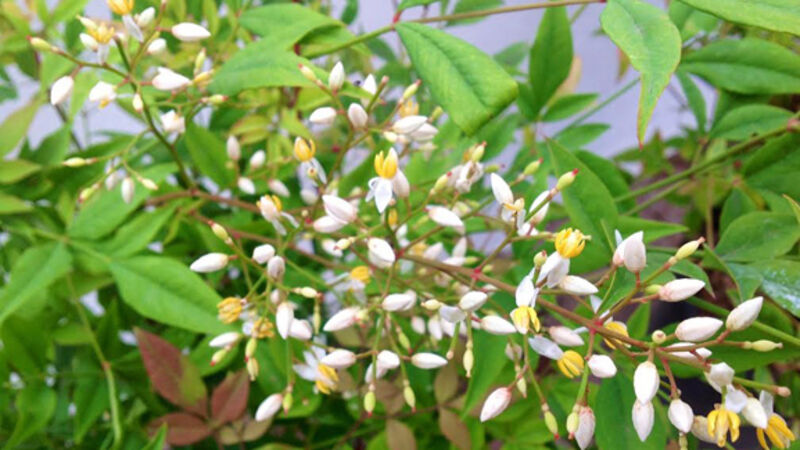A bamboo is a real plant for all seasons

If you are relying on flower to make a plant interesting then you are relying on a very finite period. Every plant needs to work hard to warrant a place in your garden. It should, where possible, have more than one area or season of interest. It’s always worth keeping an eye out for specific forms or varieties of plants, such as a golden leaved or variegated forms.
Viburnum tinus is a solid evergreen shrub which freely produces white flowers which open from pink buds. Growing to about three metres tall and about two metres wide, the species creates quite a presence and will get too big for many gardens. It’s not a plant I would rave about. When not in flower, it’s a bit dark and dull.
Keep an eye out for ‘Eve Price’ which is a more compact and manageable variety growing to about 1.5 metres. But for a much more dramatic and bright effect have a look at Viburnum tinus ‘White Egret’. Lovely mid green leaves are surrounded with a large, bright creamy white margin. This is a plant that brings something to the garden for 52 weeks in the year and I’m not relying on the flower to make the plant interesting. Deciduous Azaleas are another plant that illustrate my point. Growing to about 2.5 metres x 1.5 metres these really are aristocrats of the spring garden with plush, generous, bright, flowers during March to May, many of which are scented. But perhaps it is the autumn which is their better time of the year because they become draped with copper, red and mahogany coloured gowns. When you are using plants for texture effect rather than for flower then you will have interest for a lot longer. If you have planted some light and airy ornamental grasses amongst dense shrubs, then the softness of the grass will bring beauty and interest to the garden all year long.
Bamboos too, offer the same attributes, bringing a great sense of sound and movement. Do be careful when choosing which bamboo to use. I would be very slow to introduce most of the Phyllostachys genus into my garden and these happen to be the type of bamboo that is most widely available.
Because Phyllostachys like many bamboos is a complete and utter bully of a plant, sending suckers from its spreading rhizomes up to 20 or 30 feet away from the parent plant, paying no attention to private property laws and cropping up in neighbours gardens at will.
These can damage pipes and undermine the foundations of paths and patios. Only grow these in containers or self-contained raised beds. If youwant to grow them in the open ground you can get bamboo barrier which is an impenetrable PVC sheet which must be buried vertically between 1.5-2 metres around the bamboo to confine.
Fargesia is a much better behaved party guest forming a well behaved elegant clump of bamboo which will certainly bulk up to a substantial plant but it won’t start popping up all over the garden. So too Thamnocalamus, a more unusual bamboo, native to Tibet this is one of the finest clump forming bamboos you can get, the variety ‘Kew Beauty’ being a particularly attractive cultivar with a blue hue to the juvenile stems and leaves. However this beauty will reach about six metres high in most gardens.
Nandina domestica is known by the common name Chinese Sacred Bamboo but of course it isn’t a bamboo at all, though it offers many of the same features. A monotypic genus means it only has one species, but over 60 cultivars have now been developed, mostly in Japan. All are hardy in this part of the world with ‘firepower’ being among the best of them for pure aesthetic beauty. Growing to about 1-1.2 metres over its lifetime ‘Firepower’ is an upright but low-growing, compact form.
In the spring, new growth is a beautiful fresh lime green, followed by conical shaped sprays of white flowers during the summer. As if two seasons of interest and beauty wasn’t enough, it is at this time of the year and right through late autumn and into winter that it really comes into its own.
Not a bamboo but a real plant for all seasons in a non invasive way, do please remember that the berries that are produced after flowering are poisonous along with all parts of the plant which contains the highly poisonous hydrocyanin acid and nandonine.














